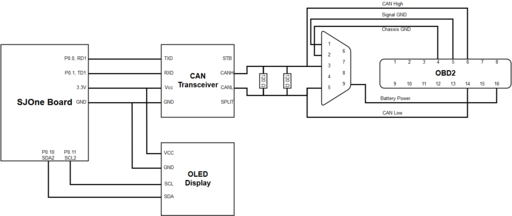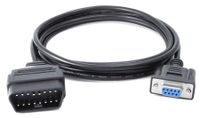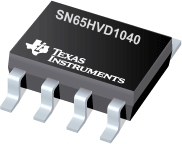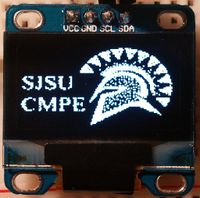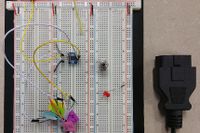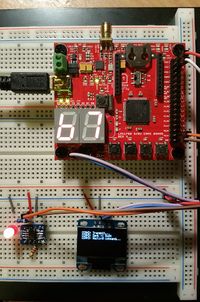Difference between revisions of "F16: OBD2 Reader"
146 user15 (talk | contribs) (→Conclusion) |
146 user15 (talk | contribs) (→Hardware Design) |
||
| Line 227: | Line 227: | ||
[[File:CmpE146_F16_G1_OBD2DB9.jpg|200px|thumb|Figure X. OBD2 to DB9 Adapter]] | [[File:CmpE146_F16_G1_OBD2DB9.jpg|200px|thumb|Figure X. OBD2 to DB9 Adapter]] | ||
| − | [[File:CmpE146_F16_G1_SN65Module.jpg|thumb|Figure X. | + | [[File:CmpE146_F16_G1_SN65Module.jpg|thumb|Figure X. SN65HVD1040 CAN Transceiver]] |
[[File:CmpE146_F16_G1_OLEDModule.jpg|200px|thumb|Figure X. OLED Display Module]] | [[File:CmpE146_F16_G1_OLEDModule.jpg|200px|thumb|Figure X. OLED Display Module]] | ||
Revision as of 10:48, 20 December 2016
Contents
Grading Criteria
- How well is Software & Hardware Design described?
- How well can this report be used to reproduce this project?
- Code Quality
- Overall Report Quality:
- Software Block Diagrams
- Hardware Block Diagrams
- Schematic Quality
- Quality of technical challenges and solutions adopted.
Abstract
This project entails the use of can bus structure to create a form of communication between our Microcontroller and a vehicle's ECU. Once connected using this protocol, our Microcontroller using the Can controller will interface with the ECU and retrieve diagnostic information stored in the ECU for debbuging. Once these codes are stored in our memory location on the Microcontroller, we will reset the diagnostic data of the ECU and clear the check engine on the car. using a transceiver and OBD2 protocol. The OBD2 codes retrieved from the vehicle are compared to the Microcontroller's database. If there is a match, a corresponding message is displayed to the user via an LCD screen. The LCD screen will use the I2C protocol to transmit the data from our Microcontroller to the LCD screen. These messages will entail diagnostic data and instructions.
OBD2 Reader
On-board vehicle diagnostics (OBD) refers to an interface that connects to a vehicle's computer and allows the vehicle to self-diagnose problems and report them. OBD-II or OBD2 is an OBD standard which the type of connector, messaging format, electrical signaling, and a list of other vehicle parameters.
The OBD2 reader is an on board diagnostic device that translates the diagnostic code from a vehicle's engine control unit (ECU) to comprehensible data for the user. This device employed several protocols from CMPE 146 lab and techniques taken from the Socialledge Wiki to implement the design. The cars onboard ECU takes all the sensory data from several sensors and units and translates it into hexadecimal numbers that it then outputs its OBD2 port. Our OBD2 ready device links with the car’s ECU and reads diagnostic information from it, which it then transmits to the microcontroller which in turn compares the information to its database codes and print a message that explains what the code means. If the codes from the ECU match the code stored on our board, the board will display the result on Hercules and an LCD device that was configured with out system. The LCD device was implemented on top of our board using the I2C protocol; it display the error message corresponding to the vehicle's obd code as well as diagnostic suggestions and further steps to take.
CAN Bus
Controlled Area Network (CAN Bus) Bus is a message-based protocol used by all vehicles. CAN bus allows devices and Microcontrollers to communicate without a host machine. Several different devices can be interfaced to CAN Bus, such as the control unit for the airbags, an anti-lock braking system, the power steering system, a proximity sensor, and the OBD2 connector.
Figure 1. CAN Bus wiring
The CAN Bus is made up of two wires, CAN-H (CAN High) and CAN-L (CAN Low). Both wires connect to all devices on the bus. A signal is transmitted as a differential pair of signals on its own wire. When the CAN-H wire receives a signal, the CAN-L wire also receives the same signal but with an opposite amplitude. The reason for this is to reduce the chance of data corruption by making it less vulnerable to noise. The CAN-H wire can go from 2.5V to 3.75V and the CAN-L wire can go from 2.5V down to 1.25V.
Figure 2. CAN Bus Communication
When the CAN Bus is implemented on a vehicle, both CAN-H and CAN-L wires must be twisted together with two 120 Ohm terminating resistors. By having the wires twisted together, they are able to eliminate any noise. The two terminating resistors are connected to both ends of the bus to eliminate any signals from reflecting. In Figure 2, Device 1 denotes the LPC1758 Microcontroller and Device n denotes a transceiver. Device n is required as the RX and Tx pins from the Microcontroller send out logical signals that need to be converted to a single differential pair which connects to the OBD2 port.
Figure 3. CAN Bus Frame
The CAN bus system has two different formats for the message frame, 2.0A and 2.0B. The difference is that 2.0A is the standard and uses 11 bits in the arbitration field, and 2.0B is the extended version and uses 29 bits in the arbitration field.
The CAN Bus data message frame is composed of a Starting Frame, an Arbitration Field, a Control Field, Data Field, Cyclic Redundancy Check, Acknowledge Field, and an End of Frame. The Starting Frame is used to indicate the start of a message when bit is zero. The Arbitration Field is used to define the message priority. The Control Field is used to describe the length of the data being sent. The Data Field is used to send the actual payload to the other CAN nodes. The Cyclic Redundancy Check is used to detect any errors in the data. The Acknowledge Field is used to let the transmitter know that they successfully received the data. The End of Frame is used to indicate the end of the data.
In the CAN system, there is no control host. When a CAN node is about to send data into the bus it first checks to see if the bus is busy. If the bus is not busy, the CAN node will send a message frame to the bus. The message frame does not contain a destination address so the message frame will be received by all nodes on the bus. Depending on the Arbitration Field, each CAN node will decide if they should ignore or accept the frame. When more than one CAN node tries to send a frame to the BUS at the same time, the node with the lower Arbitration ID will have the higher priority to the bus. The lower priority nodes will have to wait until the higher priority one is done.
Objectives & Introduction
This project aims to design an OBD2 reader using the SJOne LPC 1758 board. The reader will display a vehicle's Engine Control Unit (ECU) information via an LCD screen.
Objectives:
- Interface the SJOne board with the OBD2 reader
- Store and read external memory module through SJOne board
- Interfacing SJOne to external LCD or OLED display
Sensors and Peripherals Used:
- ECU (information source device)
- SJOne (for processing information)
- External Memory and Memory Interface
- LCD or OLED (display vehicle diagnostics)
Team Members & Responsibilities
- R Nikfar
- Electrical Engineering Advising, Can Bus protocol Design, Eagle PCB design, Electrical Components, Firmware Coding, and Mechanical Engineering sensor and Component Debugging.
- Samira Oliva
- CAN Driver Programming and Setting up the memory unit.
- Samuel Palomino
- CAN Driver Programming, OLED Display Driver Programming and Component Debugging.
- Erik Sanchez
- Setting up the memory unit.
Schedule
| Week # | Start Date | End Date | Planned Tasks | Status | Actual Outcome |
|---|---|---|---|---|---|
| 1 | 10/30/16 | 11/05/16 |
|
Completed |
|
| 2 | 11/06/16 | 11/12/16 |
|
Complete | TBA |
| 3 | 11/13/16 | 11/19/16 |
|
Complete | TBA |
| 4 | 11/20/16 | 11/26/16 |
|
Complete | TBA |
| 5 | 11/27/16 | 12/03/16 |
|
Complete | TBA |
| 6 | 12/04/16 | 12/10/16 |
|
Complete | TBA |
| 7 | 12/11/16 | 12/17/16 |
|
Complete | TBA |
| 8 | 12/18/16 | 12/20/16 |
|
Complete | TBA |
Parts List & Cost
Give a simple list of the cost of your project broken down by components. Do not write long stories here.
| Item | Qty. | Price (Total) | Description |
|---|---|---|---|
| SJOne Board | 1 | $80.00 | SJOne board |
| CAN Transceiver | 1 | $1.68 | Handles CAN bus signals voltage conversion |
| OBD2 to DB9 Adapter | 1 | $6.99 | Connects the vehicle's ECU to SJOne board |
| OLED Display | 1 | $9.99 | I2C 128x64 Display Module |
Design & Implementation
The design section can go over your hardware and software design. Organize this section using sub-sections that go over your design and implementation.
Hardware Design
Discuss your hardware design here. Show detailed schematics, and the interface here.
Hardware Interface
In this section, you can describe how your hardware communicates, such as which BUSes used. You can discuss your driver implementation here, such that the Software Design section is isolated to talk about high level workings rather than inner working of your project.
Software Design
Show your software design. For example, if you are designing an MP3 Player, show the tasks that you are using, and what they are doing at a high level. Do not show the details of the code. For example, do not show exact code, but you may show psuedocode and fragments of code. Keep in mind that you are showing DESIGN of your software, not the inner workings of it.
The program consists of one task which communicates with the CAN protocol. This single task takes care of preparing the bus for communication and also the message communication. First, the CAN bus is initialized. Then, the CAN bus is set up so that all messages on the bus are received. No filter is necessary since there are only two devices utilizing the CAN bus. Finally, the CAN bus is reset so that it's ready for communication. This concludes the set up portion of the CAN bus.
The program is also able to communicate with an external OLED display to easily see which codes are being sent and received.
- Communication Protocols
- Controller Area Network (CAN)
- To communicate with the vehicle's ECU.
- I2C
- To communicate with the OLED display.
- Controller Area Network (CAN)
Implementation
This section includes implementation, but again, not the details, just the high level. For example, you can list the steps it takes to communicate over a sensor, or the steps needed to write a page of memory onto SPI Flash. You can include sub-sections for each of your component implementation.
Testing & Technical Challenges
Describe the challenges of your project. What advise would you give yourself or someone else if your project can be started from scratch again? Make a smooth transition to testing section and described what it took to test your project.
Include sub-sections that list out a problem and solution, such as:
Issue #1
The first issue that was encountered involved the memory unit. For this project, we planned to use an AT45 IC FLASH 64MBIT 85MHZ memory. After connecting the memory module to the LPC1758, we created a text file containing the DTCs (Diagnostic Trouble Code) and tried to open the file using Eclipse and transfer the data onto the AT45. After spending days trying to that, we sought to advise of the lab assistant, Praveen. We were informed that we would not be able to open the file and transfer the data to the AT45. If we wanted to transfer data, we would have to type the code and every DTC on the Eclipse IDE, which would take too much time to do because there are about 76 pages of DTCs. Instead, we transferred the text file with the DTCs on the micro SD card and inserted the card on the LPC1758. We later learned that we did not need all the DTCs. We only chose a few DTCs which were able to be stored on the LPC1758's onboard memory.
Issue #2
The second Issue included the lack of information regarding the architecture of the can bus protocol. we originally connected the Tx, Rx from The Microcontroller directly to the can bus Hi and Lo Signals. After several days of troubleshooting, we realized that there would be a need for the specific transceivers(automotive). These transceivers would operate at a much higher frequency than our previous transceivers(500kbps).
Issue #3
After much research, it was determined that the maximum speed of the Microcontroller would not be enough for the Automotive can bus architecture. The Microcontroller's stable speed(100kbps) was much lower than automotive(500kbps). In order to fix this problem, and outside crystal was connected to the board Xtal pin.
Issue #4
Once the physical connection with the vehicle was made and hexadecimal messages were being sent through the can bus, we ran into another issue. The connectors on the J2284 or OBD2 pin to the ECU were not properly marked. This was the most vexing of all the issues due to the ambiguous nature of the problem. We trouble shooted the board, the signal and ultimately were able to narrow the problem down to wrong connection labels(manufacturer error).
Issue #5
Our last problem entailed the implementation of the software. Using given structure of the can bus we were able to create a task and store and transmit values that were not intended. This was mostly due to a wrong implementation of a function designed to convert the values of from the controller to memory. The external memory implementation was removed, and we were able to get the right hex code outputs on the Hercules terminal.
Conclusion
This project vastly improved our understanding of the LPC1758 Can Controller, Can bus architecture, Automotive standards, PID's, I2C standard, LCD interfacing, and Configuration of the Can system. This project ultimately helped our team understand several topics not mentioned in this class, and further prepared each team member to understand the troubleshooting procedures necessary when dealing with an automotive vehicle. The team was successful in retrieving the diagnostic codes from the designated vehicle and reset the check engine light of the vehicle. Our goal for the future is to create a pragmatic device that could be used to interface with a software application or platform.
Project Source Code
References
Acknowledgement
Any acknowledgement that you may wish to provide can be included here.
References Used
List any references used in project.
Appendix
You can list the references you used.

